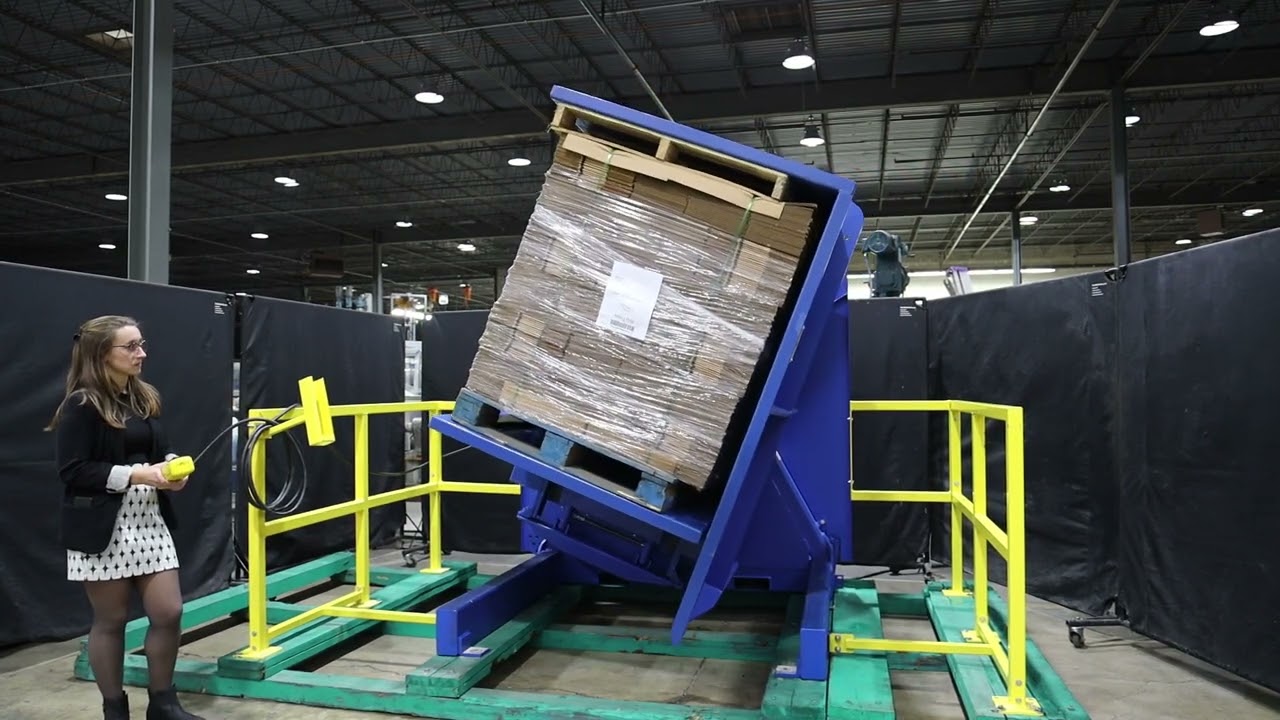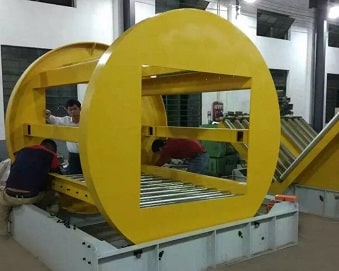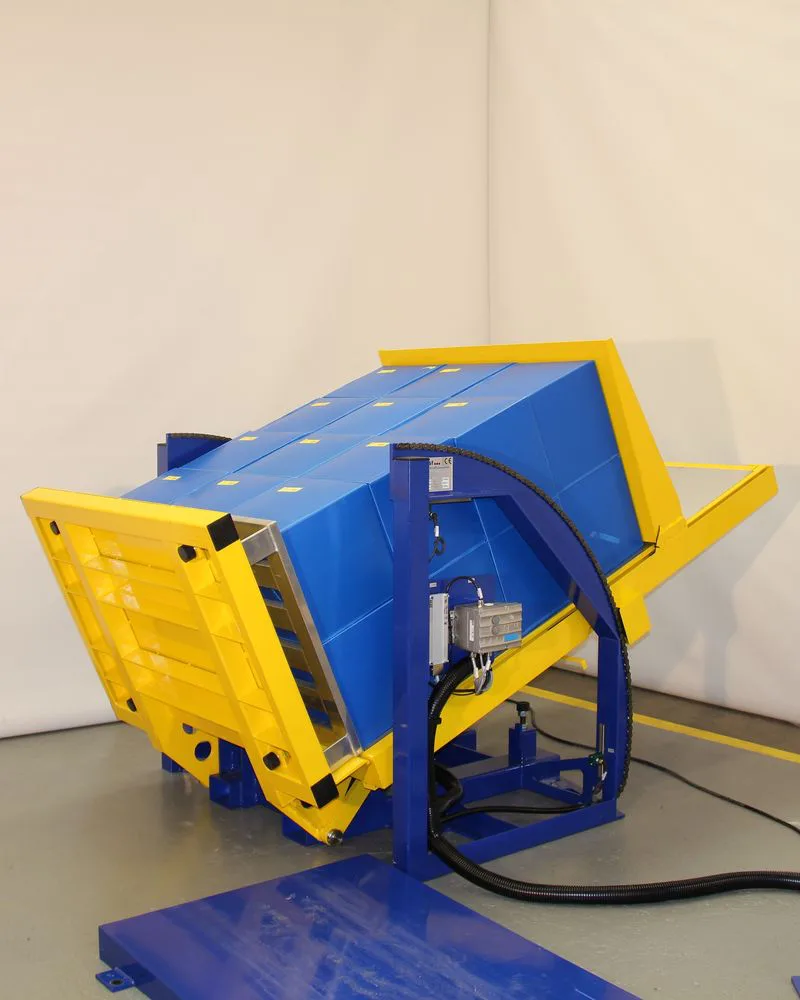Pallet Changing Machine: What’s the Best Solution for Oversized Pallets?
Handling standard pallets is one thing. But when you're dealing with oversized, heavy, or unconventional loads, everything changes. The risks multiply, the process slows to a crawl, and the potential for costly damage skyrockets. I've seen it happen time and again in factories and mills. A team of workers struggles to manually transfer a massive load, a forklift operator inches forward carefully, and everyone holds their breath. This manual process is a huge bottleneck, a safety hazard, and a drain on profits. You know there has to be a better way, a solution that brings efficiency and safety to your most challenging loads.
The best solution for oversized pallets is typically a heavy-duty, floor-level pallet changing machine or a pallet inverter with an extended opening and a high weight capacity. These specialized machines are engineered with reinforced frames and powerful clamping systems that secure the load from the sides or top and bottom. This method ensures complete stability for loads with non-standard dimensions and high centers of gravity, making the transfer process fast, safe, and automated.

Finding the right solution starts with understanding why your standard equipment isn't up to the task. It's not just about size; it's about engineering, stability, and safety. A standard machine will fail, and I want to walk you through exactly why that is. Once you see the specific failure points, you'll know precisely what to look for in a machine that is truly built to handle the big jobs. Let's dig into the details.
Why Do Standard Pallet Changers Fail with Oversized Loads?
You invested in a pallet changer to automate your logistics, but it chokes on your largest products. The load is too wide for the opening, too heavy for the motor, or too unstable for the clamps. Now, you have an expensive machine that only solves half of your problem. The most dangerous and time-consuming manual handling continues, which completely defeats the purpose of your investment. It’s a frustrating situation I’ve helped many clients navigate. Let's break down exactly why standard machines fall short.
Standard pallet changers fail with oversized loads because of fundamental limitations in their design, capacity, and clamping mechanisms. Their frames are too narrow to accommodate the width, their motors and hydraulic systems lack the power for heavy weights, and their simple clamps cannot securely grip unstable or irregularly shaped large products. This mismatch inevitably leads to equipment failure, product damage, and serious safety hazards.

Deconstructing the Failure Points
When I was starting out as a young engineer, I saw a company try to save money by using a standard pallet changer for oversized loads of sheet metal. It seemed to work for a few weeks. Then, one day, the machine's frame warped under the strain, and the load shifted and crashed to the floor. The damage was significant, but worse, it was a close call for the operator. That day taught me a lesson: a machine’s specifications are not suggestions; they are hard limits. Pushing those limits is not a shortcut; it's a gamble.
Mismatched Dimensions and Weight Capacity
The most obvious point of failure is size. Standard pallet changers are built around common pallet dimensions like 1200x800mm or 1200x1000mm. Their entire structure, from the loading bay to the clamping aperture, is designed for these footprints. An oversized load, whether it’s wider, deeper, or taller, simply will not fit. Forcing it can damage both the product and the machine.
Weight is an even more critical factor. A standard machine might be rated for 1000 kg or 1500 kg. For many industries, that's enough. But in sectors like steel, automotive, or heavy manufacturing, loads can easily exceed 2000 kg or more. A standard machine’s motor, chains, and hydraulic system are not built for that kind of force. Attempting to lift such a load will cause motor burnout, hydraulic leaks, or even catastrophic structural failure. For a plant manager like Javier Morales, whose steel mill deals with heavy products daily, using an under-specified machine is simply not an option. It introduces an unacceptable level of risk and unreliability, directly opposing the goal of increasing equipment uptime.
Inadequate Clamping and Stability
Standard pallet changers often use simple clamping methods. A "push-pull" mechanism or a single-wall pressure plate works fine for stable, uniform loads like a neat stack of boxes. However, oversized loads are rarely so cooperative. They can be irregularly shaped, like a large engine part, or have a high center of gravity, like a tall stack of bagged goods on a large pallet.
A single point of pressure is not enough to secure such a load during a 90-degree or 180-degree rotation. The load can easily shift, unbalance, and topple over mid-cycle. This not only destroys the product but poses a severe risk to anyone nearby. A proper solution for oversized items requires a more robust system, such as dual-sided clamps that apply even pressure or a combination of side and top clamps to create a secure "cage" around the product before any movement begins.
| Feature | Standard Pallet Changer Specification | Oversized Load Requirement | Consequence of Mismatch |
|---|---|---|---|
| Opening Width | 1200mm - 1300mm | > 1400mm | Load cannot enter the machine. |
| Weight Capacity | 1000kg - 1500kg | > 2000kg | Motor burnout, structural failure, safety risk. |
| Clamping Method | Single-side pressure or Push-pull | Dual-side clamping or Top & Side compression | Load shifts, product damage, machine damage. |
| Frame Structure | Standard gauge steel | Reinforced, heavy-gauge steel | Frame can bend or warp over time, leading to failure. |
What Are the Key Features of a Robust Oversized Pallet Changer?
You understand the problem now. You need a specialized machine. But when you start looking, you find many suppliers claiming their equipment is "heavy-duty." How can you tell which machine is truly engineered for the challenge and which is just a standard model with a bigger motor? Choosing the wrong machine is a costly mistake that brings you right back to the problems of downtime and safety risks. As someone who has designed and built these machines, I can tell you exactly what to look for. These are the non-negotiable features for handling oversized pallets safely and efficiently.
The key features of a robust oversized pallet changer include a reinforced, wide-clearance frame, a high-capacity hydraulic or electric power unit, and an adjustable dual-clamping system that secures the load from multiple angles. It must also have floor-level loading to simplify forklift access and advanced safety features like light curtains, safety interlocks, and pressure sensors to protect both operators and products.

Engineering for Strength and Access
A machine's strength starts with its foundation. For oversized loads, you can't compromise on the build quality. This is something I always emphasize with clients who run demanding operations, like our friend Javier at his steel mill. He understands that equipment aging is a major challenge, so investing in durability upfront is crucial.
Heavy-Duty Construction and Frame Design
Look for a frame built from heavy-gauge steel with reinforced welds, especially at stress points. The base of the machine should be wide and solid to provide a low center of gravity, preventing any wobble or tipping when handling a heavy, off-center load. A key feature for operational efficiency is a floor-level loading design. This means a forklift operator can drive directly up to the machine and place the pallet on the platform without needing a pit in the floor or a clumsy ramp system. This simplifies the workflow, speeds up cycle times, and reduces the risk of accidents during loading and unloading. It’s a simple design choice that has a massive impact on daily operations.
Advanced Clamping Systems
This is where a truly robust machine stands out. For oversized loads, you need more than just pressure; you need intelligent containment. The best systems use a dual-clamping approach.
- Dual Side Clamps: Two moving walls close in on the load from both sides. This is ideal for stable but wide products. The pressure can be adjusted to be gentle enough for fragile goods or firm enough for heavy industrial products like steel coils.
- Top and Side Clamping: For very tall or unstable loads, a combination of a top press and side clamps is essential. The top press comes down to stabilize the load vertically, while the side clamps secure it horizontally. This creates a secure "box" around the product, making it almost impossible for it to shift during the inversion or transfer cycle.
The ability to adjust the clamping pressure is critical. You don't want to crush your products. A good machine has a control system that allows operators to set the pressure based on the specific load, ensuring both safety and product integrity.
| Feature | Description | Benefit for Oversized Loads |
|---|---|---|
| Reinforced Frame | Built with thicker steel and extra welds. | Prevents bending and structural fatigue under heavy weight. Ensures long-term reliability. |
| Floor-Level Loading | Platform is flush with the factory floor. | Eliminates need for ramps/pits. Speeds up forklift operations and improves safety. |
| Dual Clamping | Secures load from two opposing sides. | Provides even pressure, prevents load shifting, handles wide or irregular shapes. |
| Adjustable Pressure | Allows operator to set clamping force. | Protects fragile goods from damage while ensuring heavy loads are secure. |
| High-Capacity Power | Powerful hydraulic or electric motor. | Provides the necessary force to lift and rotate heavy loads smoothly and without strain. |
How Can an Oversized Pallet Changer Improve Operational Efficiency and Safety?
Investing in a major piece of equipment requires a clear return on investment. It's not just about buying a new machine; it's about solving real business problems. How does this machine actually make your operation more efficient? How does it protect your people and your products? It’s easy to see the upfront cost on an invoice. It's much harder to quantify the long-term gains from fewer accidents, faster throughput, and zero product damage. But as a business owner, these are the numbers that truly matter. Let's connect the machine's features directly to your bottom-line goals.
An oversized pallet changer boosts operational efficiency by automating a slow, manual task, cutting pallet exchange times from over 15 minutes down to less than two. It dramatically improves safety by removing the need for workers to manually lift and restack heavy, unstable loads, which significantly reduces the risk of musculoskeletal injuries and accidents. This combination leads directly to higher throughput, lower labor costs, and reduced expenses from damages and insurance claims.

Quantifying the Return on Investment
For a pragmatic leader like Javier, every investment must be justified with a strict feasibility analysis. His goals are clear: increase capacity utilization, reduce operating costs, and improve profit margins. A specialized pallet changer is not just a piece of hardware; it is a tool to achieve these specific targets. Let’s look at the real-world impact.
Boosting Throughput and Reducing Bottlenecks
Consider the manual process. To change an oversized pallet, you might need two or three workers. They have to carefully de-stack the product, move it to a new pallet, and then re-stack it. This process is slow and meticulous, easily taking 15 to 20 minutes per pallet. It's a major bottleneck in any fast-moving logistics chain.
Now, compare that to an automated pallet changer. A single forklift operator loads the machine. The operator pushes a button. In 60 to 90 seconds, the entire load is securely transferred to the new pallet. The operator unloads it and is on their way. What took three people 20 minutes now takes one person less than two minutes. In an eight-hour shift, the difference is staggering. You go from handling maybe 20-25 oversized pallets to handling over 200. This directly addresses the goal of increasing capacity utilization by eliminating a critical point of delay.
Enhancing Worker Safety and Ergonomics
This is the most important benefit, and it has a direct financial impact. Manual handling of heavy and awkward loads is one of the leading causes of workplace injuries, especially back injuries. These injuries are costly. You have direct costs from workers' compensation claims and medical bills. You also have indirect costs from lost workdays, the need to train replacement staff, and decreased team morale.
An oversized pallet changer removes the worker from the lifting equation entirely. The machine does all the heavy work. This single change can virtually eliminate a whole category of serious injuries at your facility. For an owner, this means a safer work environment, a more stable workforce, and significantly lower insurance premiums. It is a proactive investment in your people's well-being, which always pays dividends.
| Metric | Manual Process | Automated Pallet Changer | Impact & ROI |
|---|---|---|---|
| Time per Pallet | 15-20 minutes | < 2 minutes | 90% time reduction. Massive boost in throughput. |
| Labor Required | 2-3 workers | 1 operator | 50-66% labor reduction. Frees up staff for value-added tasks. |
| Product Damage Rate | High (due to shifting, dropping) | Near-zero (secure clamping) | Reduces waste. Eliminates costs from damaged goods and rework. |
| Injury Risk | Very High (back strain, crush) | Very Low (operator is separate) | Reduces insurance costs. Improves worker safety and morale. |
My Insights: Beyond the Machine Itself
I remember visiting a client's facility years ago. They were running a large bottling plant and had just bought a top-of-the-line pallet inverter for their oversized loads. It was a powerful, expensive machine from a reputable brand. But when I got there, it was sitting idle most of the time. The problem wasn't the machine; it was the integration. The workflow was all wrong. The forklift paths created a traffic jam, the staging area for empty pallets was on the wrong side, and the operators hadn't been properly trained on its features. They had the right tool, but they were trying to use it in a process designed for manual labor.
That experience taught me a crucial lesson that I share with every client, especially strategic thinkers like Javier: buying a machine is easy. Building a solution is hard. You are not just purchasing a piece of steel; you are investing in a new operational process. The success of that investment depends on thinking beyond the hardware itself.

It's a System, Not Just a Machine
The pallet changer is one piece of a larger puzzle. To get the most out of it, you must consider the entire workflow.
- Upstream: How does the product arrive at the machine? Is the forklift path clear and direct? Is there enough space to maneuver?
- At the Machine: Where will you stage the incoming pallets? Where will you store the new pallets for the exchange? Where do the old, empty pallets go? A well-designed layout keeps everything flowing smoothly without creating new bottlenecks.
- Downstream: Once the pallet is changed, where does it go next? To a stretch wrapper? To a staging area for shipping? The exit path must be as efficient as the entry path.
This is why I always tell people to look for a partner, not just a supplier. A good partner will help you analyze your current workflow and design an integrated system that maximizes efficiency from start to finish.
Customization is Key
There is no "one-size-fits-all" solution for oversized loads. Your product is unique. Your facility is unique. Your challenges are unique. A standard machine off a shelf is unlikely to be a perfect fit. You need to work with a manufacturer who is willing and able to customize their equipment. This could mean:
- Adjusting the opening width and height to perfectly match your largest load.
- Upgrading the weight capacity to handle your heaviest products with a safe margin.
- Modifying the clamping system—using special pads to protect delicate surfaces or shaping the clamps to grip an unusual product.
- Integrating the machine's controls with your existing factory systems, like an MES platform, for full automation and data tracking. This is critical for anyone pursuing a digital transformation strategy.
Think About the Future
A major capital investment should serve you for many years. When choosing a solution, don't just solve today's problem. Think about tomorrow's.
- Scalability: Will this machine be able to handle a potential increase in your product size or weight in the future?
- Compliance: Does the machine meet the latest safety standards? Is it designed with energy efficiency in mind to help manage fluctuating energy costs? This is a major concern for energy-intensive operations like a steel mill.
- Connectivity: Is the control system ready for the future? Can it be easily upgraded or connected to IoT sensors for predictive maintenance and data analysis?
Choosing the right oversized pallet changer is about more than just specifications. It’s about finding a robust, flexible, and future-proof system that becomes a seamless part of your operation and a true driver of efficiency and safety.
Conclusion
Choosing the right oversized pallet changer means finding a customized, integrated system. This approach ensures maximum safety, boosts operational efficiency, and delivers a strong return on your long-term investment.



